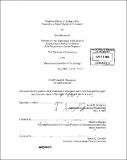| dc.contributor.advisor | Martin Culpepper. | en_US |
| dc.contributor.author | Bourgeois, Jacob | en_US |
| dc.contributor.other | Massachusetts Institute of Technology. Dept. of Mechanical Engineering. | en_US |
| dc.date.accessioned | 2006-05-15T20:36:17Z | |
| dc.date.available | 2006-05-15T20:36:17Z | |
| dc.date.copyright | 2005 | en_US |
| dc.date.issued | 2005 | en_US |
| dc.identifier.uri | http://hdl.handle.net/1721.1/32875 | |
| dc.description | Thesis (S.B.)--Massachusetts Institute of Technology, Dept. of Mechanical Engineering, 2005. | en_US |
| dc.description | Includes bibliographical references (p. 38). | en_US |
| dc.description.abstract | Planar magnet-coil actuators are used in many different MEMS devices. This report describes one way to improve the actuator range per current input of planar coil actuators. This is accomplished by adding a flux channel around and beneath the actuator's magnet. The Lorentz force is created by putting a current carrying planar coil over a magnet in an actuator assembly. The Lorentz force depends on the current vector and the magnetic field vector. In this thesis the Lorentz force is altered by changing the direction and concentration of the magnetic field. Magnetic fields may be modeled as flux lines traveling from the north face of the magnet to the south face along the least resistant path. Iron is a magnetic material with 4000 times the magnetic permeability of air, so when iron is placed in a magnetic field, the majority of the magnetic flux will travel from North to South through the iron. This "channel" alters the way the magnetic field would normally travel given the bare magnet. The magnetic flux that travels through the channel depends in part upon the channel geometry. The result of varying the width of this channel is modeled and tested in this work. The physical principle was examined in simulations by varying channel width and then extracting the corresponding actuator output. A relationship was fit to the simulated results. | en_US |
| dc.description.abstract | (cont.) The actuator output augmentation was maximized at a critical width and remained steady thereafter. Beyond the critical width, the addition of the flux channel was able to produce more than 45% increase in the actuator force. Experimental results showed less than a 5% difference from the simulated results. | en_US |
| dc.description.statementofresponsibility | by Jacob Bourgeois. | en_US |
| dc.format.extent | 42 p. | en_US |
| dc.format.extent | 2421004 bytes | |
| dc.format.extent | 2420861 bytes | |
| dc.format.mimetype | application/pdf | |
| dc.format.mimetype | application/pdf | |
| dc.language.iso | eng | en_US |
| dc.publisher | Massachusetts Institute of Technology | en_US |
| dc.rights | M.I.T. theses are protected by copyright. They may be viewed from this source for any purpose, but reproduction or distribution in any format is prohibited without written permission. See provided URL for inquiries about permission. | en_US |
| dc.rights.uri | http://dspace.mit.edu/handle/1721.1/7582 | |
| dc.subject | Mechanical Engineering. | en_US |
| dc.title | Modeling effects of adding a flux channel to a planar magnet-coil actuator | en_US |
| dc.type | Thesis | en_US |
| dc.description.degree | S.B. | en_US |
| dc.contributor.department | Massachusetts Institute of Technology. Department of Mechanical Engineering | |
| dc.identifier.oclc | 62588658 | en_US |
